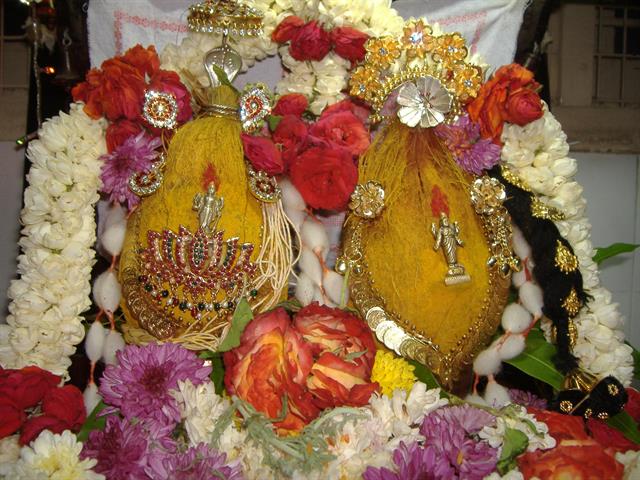Anantha Padmanabha Vratha
Contents
· Introduction
· Festival Rituals
· Puranic Reference
· Vratha Katha
Introduction
Anantha Padmanabha Vratha is a festival dedicated to Lord Vishnu. Lord Vishnu appears as Anantha Padmanabha, reclining on the couch of “Anantha”, a thousand hooded serpent. Anantha also means “infinite”. This vratha is observed by married couple for marital bliss.
Festival Rituals
 The festival is celebrated on the 14th day of Bhadrapada Shukla Chaturdashi (14th day of waxing moon in the month of Bhadrapada Masa, Sep- Oct). The festival is known as Anantha Chaturdashi, as the festival is celebrated on the 14th day of the month. The vratha is performed by placing two Kalashas along with the Anantha Daara (thread). One Kalasha (Kalasha refers to placing of a coconut smeared with turmeric and tilak on a copper pot filled with river water and raisins. The copper pot is decorated with fourteen betel leaves and on the betel leaves is placed the coconut) is decorated with yagnopaveetham and dharbhe/sacred grass indicating Lord Anantha Padmanabha. The sacred grass (seven in number) is tied together to form a hood, representing Anantha and the other Kalasha is decorated with jewellery indicating Goddess Lakshmi. Both the kalashas are decorated with garlands. Then Lord Anantha Padmanabha and Goddess Lakshmi are invoked by performing the Shodashopachara Puja. The Puja is performed using 14 varieties of flowers and leaves. Special sweets are prepared and offered to the Lord. Athirasa, a sweet made of rice floor, jaggery and coconut is prepared and offered to the Lord. Puran Poli is also made and offered to the Lord as Neivedhya. All the sweets are offered in 14 numbers, like 14 puran poli, 14 Athirasa etc. Couples are invited for lunch. People who perform this vratha are blessed with Ayush (long life), Arogya (health) and Gyana (knowledge). The Anantha Vratha is observed for 14 years and during the 15th year, Udayapane (a ritual performed for ending a vratha formally) is performed.
The festival is celebrated on the 14th day of Bhadrapada Shukla Chaturdashi (14th day of waxing moon in the month of Bhadrapada Masa, Sep- Oct). The festival is known as Anantha Chaturdashi, as the festival is celebrated on the 14th day of the month. The vratha is performed by placing two Kalashas along with the Anantha Daara (thread). One Kalasha (Kalasha refers to placing of a coconut smeared with turmeric and tilak on a copper pot filled with river water and raisins. The copper pot is decorated with fourteen betel leaves and on the betel leaves is placed the coconut) is decorated with yagnopaveetham and dharbhe/sacred grass indicating Lord Anantha Padmanabha. The sacred grass (seven in number) is tied together to form a hood, representing Anantha and the other Kalasha is decorated with jewellery indicating Goddess Lakshmi. Both the kalashas are decorated with garlands. Then Lord Anantha Padmanabha and Goddess Lakshmi are invoked by performing the Shodashopachara Puja. The Puja is performed using 14 varieties of flowers and leaves. Special sweets are prepared and offered to the Lord. Athirasa, a sweet made of rice floor, jaggery and coconut is prepared and offered to the Lord. Puran Poli is also made and offered to the Lord as Neivedhya. All the sweets are offered in 14 numbers, like 14 puran poli, 14 Athirasa etc. Couples are invited for lunch. People who perform this vratha are blessed with Ayush (long life), Arogya (health) and Gyana (knowledge). The Anantha Vratha is observed for 14 years and during the 15th year, Udayapane (a ritual performed for ending a vratha formally) is performed.
Anantha Daara (thread)
An important ritual of Anantha Vratha is tying of the sacred red thread consisting of 14 strands. Some people even make 14 knots out of the 14 threads.
The 14 strands indicate the 14 years of vratha performed by Pandavas during vanavasa. The Anantha Daara (thread) is also sanctified by worshipping with kumkum. After performing the puja, the Anantha Daara is tied on the left hand by women and on the right hand by men.

Puranic reference
Lord Krishna suggested that King Yudishtira perform this vratha during their vanavasa, (period of exile) to get rid of their sorrows and bring back the lost wealth and prosperity. Accordingly, King Yudishtira performed the vratha for 14 years. Thus, this vratha is observed for 14 years.
Vratha Katha
 There once lived a young girl Susheela who was born to a Brahmin- Sumanta and his wife Deeksha. Susheela lost her mother early and Sumanta married another woman known as Karkashe. Karkashe was very quarrelsome with Susheela. When Susheela came of marriageable age, Sage Kaundinya came looking for a bride to Sumanta’s house. As Sumanta wanted his daughter to get rid of the harassment at the hands of Karkashe, he got Susheela married to Sage Kaundinya. Sumanta could only give a little of fried wheat flour to his daughter as marriage gift.
There once lived a young girl Susheela who was born to a Brahmin- Sumanta and his wife Deeksha. Susheela lost her mother early and Sumanta married another woman known as Karkashe. Karkashe was very quarrelsome with Susheela. When Susheela came of marriageable age, Sage Kaundinya came looking for a bride to Sumanta’s house. As Sumanta wanted his daughter to get rid of the harassment at the hands of Karkashe, he got Susheela married to Sage Kaundinya. Sumanta could only give a little of fried wheat flour to his daughter as marriage gift.
While Susheela and Kaundinya were on their way to the Sage’s Ashram, Susheela saw a group of Brahmins and their wives all dressed in red colour attire performing puja on the banks of a river. Susheela enquired with the Brahmins about the puja. She got to know the details of the puja from the ladies and the fruits of performing the Puja. Susheela then desired to perform the puja as that day happened to be Bhadrapada Shukla Chaturdashi. She then joined the other Brahmins and ladies gathered on the river banks and performed the puja. She distributed half of the wheat flour to the Brahmins and returned to Sage Kaundinya’s ashram. As a result of the vratha, the couple lead a prosperous life. Soon the relatives of Sage Kaundinya also wanted to perform the Vratha.
One day, when Sage Kaundinya saw the red thread on the wrist of Susheela, he got enraged, and without even waiting for an explanation from his wife forcibly removed the thread from her wrist and threw it in fire. Susheela immediately took the half burnt thread and immersed it in milk. This act proved too dearly for Sage Kaundinya. He soon lost his wealth, cattle and his relatives also deserted him. He then realised his folly of throwing the sacred thread in fire and taking the Anantha Padmanabha vratha lightly.
Sage Kaundinya, to repent for his folly went in search of Lord Anantha Padmanabha. He entered a forest frantically searching for the Lord. After several days of search for the Lord, without food and water, he fell down in the forest. Lord Vishnu came in the guise of a Brahman and revived the sage. The Lord then took him to His palace and appeared before the sage in His original form along with goddess Mahalakshmi. Sage Kaundinya pleased with the darshan of Lord Vishnu chanted several shlokas in praise of Lord Vishnu. The Lord then blessed Kaundinya with three boons of: wealth, ability to follow dharma and mukthi saubhagya.
Sage Kaundinya returned home and then performed the Anantha Padmanabha Vratha for 14 years. He then led a life of contentment and happiness. Several kings like Janaka, Harishchandra Sagara and Dilipa and Sage Agastya in the past have performed the Anantha Padmanabha Vratha.
In the states of Maharastra and Andhra Pradesh, Anantha Chaturdashi is celebrated with great pomp as it is the last day when the idol of Lord Ganesh worshipped during Ganesh Chaturthi is immersed in water.
http://www.divinebrahmanda.com/2012/09/anantha-chaturdashi-vratha-or-sri-anantha.html
http://divyashaligram.com/articles/ananth_chaturdashi.html#.U8DhXD-Sw-M
